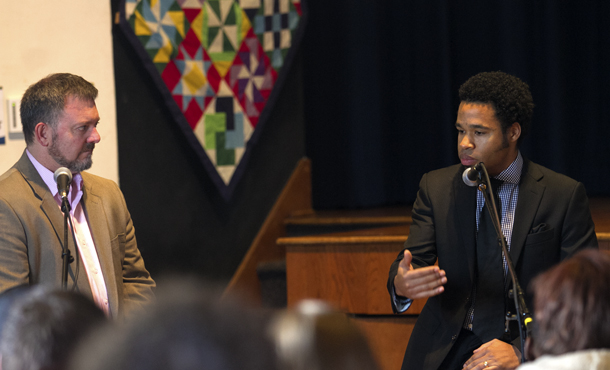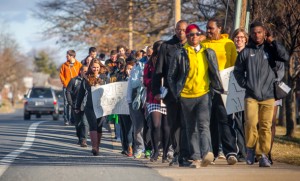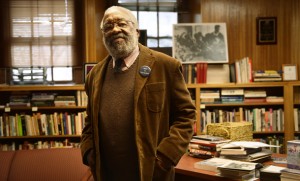Two Eastern Mennonite University professors – one white and one black – gave back-to-back chapel talks in the past week that highlighted the impact of Dr. Martin Luther King Jr. and his compatriots on the past, present and (they hope) future of their university.
Addressing a well-filled Lehman Auditorium on Jan. 17, history professor Mark Metzler Sawin traced EMU’s history from the early 1940s and the first admission of black students, through the 1960s, when visiting black Mennonite activists challenged the white Mennonite community to raise their voices against racial inequality.
Before an even larger crowd on Jan. 20, seminary professor David Evans (an expert on history and mission) spoke of the impact of King on the nation – indeed the world – but stressed that “we’ve domesticated him,” making him “palatable to our own image, our own dreams,” rather than responding to his call to address the “structural issues behind poverty.”
Both speakers shared a common theme: the dangers of adulation.
King’s posthumous transformation from man to superhero is “dangerous,” Sawin said, because such moral leaders are not “giants,” but regular people “who stumbled and wandered and worried as they strove to make a better world.”
“Take the first step”
Instead of comparing ourselves to King’s outsized image and yielding to feelings of fear and inadequacy, Sawin suggested following the example of King and those in the Eastern Mennonite community who struggled for integration: “Take the first step in faith,” Sawin said, quoting King. “You don’t have to see the whole staircase. Just take the first step.”
EMU’s predecessor, Eastern Mennonite College, took its first steps toward desegregation, in defiance of local and state law, in the late 1940s. This change was not without controversy within the Mennonite community: though EMC became the first historically white college in Virginia to reverse its racial policy and accept a black student in 1948, the Virginia Mennonite Conference did not lift its strictures on integrated worship, including shared communion, foot-washing, and the kiss of brotherhood, until 1955.
Facing social, financial and academic obstacles (including overt and covert racism), the first six black students did not stay to complete their degrees, based on Sawin’s search of EMC records. Local resident Peggy Webb was urged to head to Hesston College in Kansas for her first two years of college, before EMU belatedly let her enroll in 1950-51 and earn a degree in 1954. Her tenacity was surely influenced by her mother, Roberta Webb, a teacher and member of Broad Street Mennonite Church, who was a strong advocate of racial equality.
By the mid-1950s and 1960s, a handful of Mennonites – some from Eastern Mennonite, including Titus W. Bender ’57 – were active in the civil rights movement. (Bender, a professor emeritus who resides in Harrisonburg, spoke during chapel earlier in the week of his experiences as a pastor in the 1960s working on racial reconciliation efforts in Mississippi.) But while Mennonites were strong critics of the Vietnam War, their silence on civil rights eventually prompted King to level criticism. “Where have you Mennonites been?” he asked one church leader.
Prodded into action by the Hardings
The EMC community was eventually prompted into further action by African-American Mennonite activists Vincent and Rosemarie Harding (Vincent will speak on campus in February). During two visits to EMC in 1962 and 1963, the couple concluded that most white Mennonites were not aware of the effects of segregation. They challenged those who were aware to set aside their strict non-resistance practices to advocate for racial equality. In response, two professors formed an integrated committee that became largely responsible for the desegregation of Harrisonburg’s schools and hotels. Other Mennonite efforts followed, including attention to the subject by the official, and very popular, radio program of the Mennonite Church, “The Mennonite Hour.”
In his Monday chapel talk, Evans brought the discussion into the present by elaborating on Sawin’s suggestion that King’s image has been burnished, the jagged edges smoothed by the passage of time and the nation’s collective memory. King has been heavily memorialized – in the names of streets, schools and community centers; with larger-than-life statues; and in simplistic lessons for schoolchildren, said Evans. King is one of three Americans to be honored with a federal holiday. But these symbolic gestures have made him “less than the revolutionary he was.”
“By domesticating him, we’ve made him too big to imitate and perhaps too nice to matter,” Evans said. “Too many of us forget that though, today, King is revered, yesterday he was reviled.”
Motivated by divine discontent
Considered a Communist and an agitator, King was critical of white supremacy, economic exploitation, racial oppression, and worldwide violence. Though he advocated non-violence and passive resistance, King confronted white America with “anger, discontent, and maladjustment”– all qualities that Evans pointed out are removed from today’s popular image of King.
The collective memory of our nation has forever linked King to his famous “I Have a Dream” speech delivered in August 1963 at the March on Washington for Jobs and Freedom. Yet the qualities required to be a dreamer, Evans said, are those of the perpetually dissatisfied, what King himself described as the “divine discontent.” These qualities made King a towering force of energy, charisma and inspiration, but they also made him dangerous – and eventually led to his death.
To best honor King, Evans said, see him as who he was: as the revolutionary thinker expressing the anger of moral outrage, as a man of normal stature rather than the moral giant, as a culpable human with faults and excesses, and as the perpetual dreamer unsatisfied with the inequities of the world.
And to best honor King, “do not let the memory of a giant King comfort us more than the history of this small man. We can’t be content with the domestication of MLK or what he stood for. Be maladjusted. Be divinely discontented” about social and economic inequalities here in our own community, Evans said. “For if we are truly to walk in the way of Martin Luther King Jr., the missionary, we must be willing to walk as he walked.”




